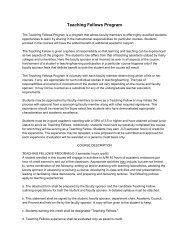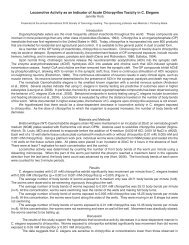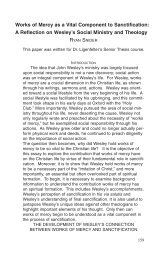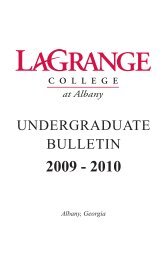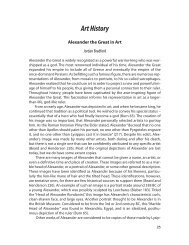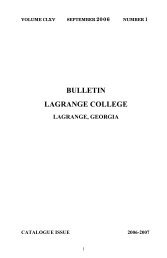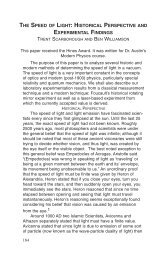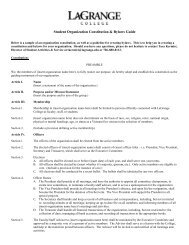undergraduate bulletin - LaGrange College
undergraduate bulletin - LaGrange College
undergraduate bulletin - LaGrange College
Create successful ePaper yourself
Turn your PDF publications into a flip-book with our unique Google optimized e-Paper software.
the academic work as measured by an overall grade point average. The quantitative standard<br />
establishes the pace at which the student must progress to ensure completion of the degree<br />
program within the allowable maximum timeframe. Financial aid recipients must meet all of<br />
these standards to be making satisfactory academic progress and to receive financial aid.<br />
QUALITATIVE STANDARD (GRADE POINT AVERAGE)<br />
A student is expected to adhere to the ―Academic Standing and Probation‖ grade point average<br />
(GPA) requirements outlined in this Undergraduate Bulletin in order to be considered in ―good<br />
academic standing‖ and to qualify for financial aid. The cumulative grade point average is based<br />
on all courses taken at <strong>LaGrange</strong> <strong>College</strong>. <strong>LaGrange</strong> <strong>College</strong> defines ―good academic standing‖<br />
as follows:<br />
a student with fewer than 30 earned hours must maintain a minimum of a 1.75 cumulative<br />
GPA;<br />
a student with 30-59 earned hours must maintain a 1.90 cumulative GPA;<br />
a student with 60 or more earned hours must maintain a minimum cumulative GPA of 2.0.<br />
The Provost monitors the grade point average component of the SAP policy each semester. Any<br />
student whose cumulative GPA is below the established minimum standard may be placed on<br />
academic probation or academic suspension.<br />
QUANTITATIVE STANDARD (RATE OF PROGRESS / PACE)<br />
A student receiving financial aid is expected to progress through the degree program of study at a<br />
pace that ensures the completion within the maximum timeframe defined below. The rate of<br />
progress (pace) is computed by dividing the cumulative number of hours that the student has<br />
successfully completed (earned credits) by the cumulative number of hours that the student has<br />
attempted. A student is considered to be making measurable progress toward the completion of a<br />
degree program by maintaining an overall rate of progress of 67%. This standard applies to all<br />
financial aid recipients, regardless of full-time or part-time enrollment status.<br />
Attempted hours are those credit hours for which the student is registered on or after the<br />
conclusion of late registration (drop/add). Earned hours are successfully completed courses in<br />
which grades of A+, A, A-, B+, B, B-, C+, C, C-, D+, D, or P are awarded, so long as credit is<br />
earned. Grades of F, Incomplete (I), Withdrawal (W), No credit (NC), Not Reported (NR), Audit<br />
(AU), or Audit Withdrawn (AW) do not count as successful completion of a course. In<br />
evaluating the rate of progress, please note the following:<br />
Withdrawals, incompletes, and failed courses are considered attempted hours but not<br />
earned hours. If an incomplete course impacts a student‘s satisfactory academic progress<br />
standing, then it is the student‘s responsibility to notify the Office of Financial Aid when<br />
a final grade is reported.<br />
Audited courses are not considered attempted or earned credit hours.<br />
Transfer credits, including courses taken as a transient student, do not count in the<br />
calculation of <strong>LaGrange</strong> <strong>College</strong> GPA, but are included in the attempted hours, earned<br />
hours, and maximum time frame standards.<br />
25




